Ever since Nikon produced the original legandary Nikon F, they have been at the forefront of SLR design. Nikon for years was the dominate player in the SLR professional market and their cameras from the 1970’s have gone beyond earth serving NASA in both the film and digital eras. But whilst sought after bodies can still command a pretty penny you can pick perfectly sevicable but overlooked bodies for peanuts making them a great starter. Here’s my 10 overlooked bargains.
Nikon on a Budget ?
Nikon did not invent the SLR but they perhaps are the company that are synonymous with it. Their 1959 Nikon F, very much set the standard and Nikon’s build quality means you can still pick up and use a 1950’s Nikon F today. They were the last company making fully fledged high end SLR film cameras only pulling out from the market last year with the demise of the Nikon F6. Arguably the pinnacle of film camera evolution.
And whilst buying a classic Nikon film body isn’t exactly cheap. For those of you on a budget there are several bodies you can buy for under £20GBP. Or less than £45 with a lens attached. In fact 2 of the bodies I’ve personally bought for a quid or less and quite a few other for not much more.
Nikon are the only camera maker that have stuck with the same mount*. on their dSLR as on that original Nikon F*. This means vintage film era lens, you can buy can still be used with many (to varying degrees) Nikon dSLRs and Mirrorless cameras sold today. At least 2 of the cameras on this list will fully work with most modern lenses some others on the list will function but without the autofocus. This makes Nikon a great long term start for someone wanting to get into 35mm SLR film photography
After this top 10 I’ve included a brief guide to Nikon F mount lens technology in case you are wondering what all the terms mean.
10 F50 (N50)
By the early 90’s Nikon had a problem. Rivals Canon stole a massive leap by ditching their legacy mechanical mount. Their EOS cameras outclassed Nikon in Autofocus speed and accuracy. Nikon need a camera to comeback against this onslaught and use their new faster AF-I lenses.
This is not that camera.
The Nikon F50 launched as their budget model after the comeback camera (F90 aka N90). But unlike the F90 and F70, it could only use the older slower AF-D autofocus system. So no AF with the newer AF-I or AF-S lenses (although they will meter and manually focus). This is the successor to the F-401X. It actually shares the same single focal point 6 zone matrix metering AM200 module. But it’s worth noting that module came from the F4.
What you do get is an updated control layout. With the PSAM and scene modes we’re used to on modern cameras. But don’rt expect a mode or command dial. this is early 90’s push button stuff. It’s broadly fine in use but to do things like a AEL lock requires some dexterity.
I prefer the older analogue dials of the F-401 series but this is a fine camera with incremental improvements over its predecessor. It would be followed by the F60 which features later but again uses the same chip.
Jim Grey has just reviewed this on his blog.
9 F-601m (N6000)
On one level this is the most advanced manual focus SLR Nikon has ever produced. But is also is one of their most flawed cameras missing its entire raison d’être.
It is the successor to the Nikon FA with it’s legendary matrix metering. Essentially a F-601 (N6006) but with the AF module removed and a manual focus screen. They also tore out the built in flash but at least you can use compatible speedlites. It is a typical early 90’s plastic bodied LCD controlled camera with motordrive & DX coding. You can completely override the DX and you do get a cable point.
Problem is this camera provides the the best support to AF lenses not manual focus. Stick on a manual focus AI or AI-S lens and you loose the matrix metering. The exceptions are grand total of 3 CPU manual focus lenses that Nikon made. You can mount and use almost any F mount lens from the AI revision until AF-P lenses.
If you can live with the flaws it’s fine. But for me, it places it behind the other 3 manual focus cameras on the list.
8 F-401 Series

The Nikon F-401 (N4004) arrived in 1987 and the budget model of Nikon’s AF line up. Revised with that AM200 module from the Nikon F4 in 1989 with the F-401S (N4004s). This in turn would be followed by the F-401X confusingly called the N5005 in US. This offers a wider range of slower shutter speeds.
These also shared a unique design with a dials for both shutter and aperture setting on top plate. They are also notable as first Nikon cameras to sport a built in TTL flash. Its a bulk beast of a 80’s cam and looks and sound more pro than it is. For that I rank it ahead of the F50 which also uses the AM200 and it’s frankly easier to use although lacks all the bells and whistles of the modes.
I reviewed the F-401 (the one without the AM200). It’s still quite tidy.
7 Nikon EM
If Nikon launched this camera the same way today the company would have had its reputation shredded. Literally sold on the premise as one for the ladies. This is the smallest lightest Nikon film SLR body. Clearly the ladies not being capable of using a marginally heavier, bulkier camera that could also do without manual modes. The EM only shoots in aperture priority.
It’s the first Nikon to use (a little) polycarbon plastic. Snorted at in its day but now felt a somewhat sleeper classic. Surprisingly robust, it actually makes a good back up body. You can use it quasi-manually in the flash mode at 1/90. But also if you drop the batteries out and leave it in Auto it shoots at 1/1000. (Thanks to Mike Eckman and Peggy Marsh for double checking that for me).
If buying second hand keep an eye out for one with the pancake 50mm 1:1.8 Nikon E series lens. It’s a sleeper classic but bear in mind you can pick up the lens for £20-40 don’t pay over the odds.
Read reviews on Peggy Marsh’s Camera Go Camera, Mike Eckman and Alex Luyckx’s blog
6 Nikon F60 (N60)

The F60 was the replacement for the F50. It looks more modern with a more typical mode dial and command thumb dial. But the AF/exposure model is still the AM200 that débuted in the 1988. It is a much better camera to live with than the F50 in layout. But tech wise this is basically a a 1980’s camera under the late 90’s skin.
That skin is plastic but the core is heavier and more robust feeling than the cameras that came after it. Like the F-50 and F-401 series it works best with older AF or AF-D lenses. Newer AF-I/AF-S lens can’t auto focus but do meter. Manual focus (AI revision) lenses can be used un-metered. Many prefer it to the F65 and F55 which succeed it,
For reviews see Jim Grey’s Down the Road
5 Nikon F55 (N50, U) 2002
The more budget of the 2 camera that replaced the F60. It does ramps up the spec with with a new AF/metering module the Nikon Multi-CAM 530. This up the focus point from 1 to 3 although you still just got a 5 segment 3D matrix meter. Like it predecessors you got a camera still wedded to older AF & AF-D, which was looking decidedly cheap in 2002. The same module ironically is in the D40 a budget dSLR. Oddly that was the first Nikon dSLR to ditch AF-D autofocus. You can use AI manual focus lenses but without metering.
It is light and tichy. It looks like and feels like a modern dSLR but not as robust as the older F50. That’s notable with the lens mount which is erm… plastic 😮.
But build quality aside IMHO it offers a better range of features than the F60. For me if you can live without AF-S support and cost is tight, the F55 gives you the a good option for peanuts. Just don’t drop it. Read my review here.
4 Nikon FE10
At this point some of you will be wiping spittle/tea/beer off you monitor and screaming “BUT THAT’S NOT A NIKON“.
Bear with me.
In fact it is a Cosina camera based on a model made 2 decades earlier.
But Why ?
By the mid 90’s the main focus was on AF bodies for the Western markets. But there remained a market for simpler basic cameras for both film/art college students and for the burgeoning developing world. Nikon were not in a position to make a cheap SLR for these markets. But they knew someone who was and they weren’t alone.
Two decades before Cosina launched the CT-1. It was a reasonable if unremarkable SLR of it’s time with centre-weighted metering and K-mount. It was reasonably successful. Cosina would revise it numerous times as other CT-1 and CT models well into the 80’s.
The CT-1 models were the basis for a wide range of cameras that Cosina made for other folks. Pretty much everyone came knocking from Nikon, Canon, Olympus, Zeiss Icon, Vivitar and even W.B. Haking to name just a few. The chassis was used for both SLR and rangefinder cameras well into the 21st century
Nikon got the FM10 and FE10 from this deal. The 1995 mechanical shutter FM10 is the better known . It remained one of only 2 film SLRs sold after 2006. And was still on sale until the last few years. Scoff you might but it can claim the longest sales run of any Nikon branded bodied.
The 1996 FE10 is the electronically controlled shutter sister to the FM10. It would not survive the 2006 cull and hence is available cheaper. You get manual and AP mode for any AI lens on that has an aperture ring with a good centre weighted meter. It dies if the battery fails and very plastic compared to traditional Nikon manual focus cameras. But if you shoot any other SLR system you won’t notice that.
If you can avoid getting with the bundled Nikon 35-70mm it was bundled with. It’s not a Nikon lens and very below par. But you’ll struggle to buy without.
3 Nikon F65
The Nikon F65 offers so much but is slightly cack handed in the delivery. The more upmarket of the 2 cameras spawned from the F60. Spec wise it is top notch. Not just capable of both AF-D & AF-S support, you get VR support. The Nikon Multi CAM 900 module gives 5 points of AF as well as a 6 segment 3D matrix metering. The same module is also used in the D50, D70 & D100 dSLR.
It just feels a bit less well made than the F60. Flash sync weirdly drops from 1/125 to 1/90 . Ergonomically it is beaten by another on this list too which represents a better buy IMHO. But that said this is capable with a wide range of lens support. Read my full review here.
2 Nikon F-301 (N2000)
In short this was a second thought. Nikon launched the F-501 (N2020) and gave the world the first successful SLR with autofocus. For some reason Nikon execs decided there should be a manual model to match (despite selling the FE2, FM2, FA and FG20 alongside.
Essentially just a F-501 stripped of the AF control motor and electrics. it’s very much a camera of the era. You could imaging Tubbs shooting it on a stake out in Miami Vice.
It lacks matrix metering but has Nikon’s centre-weighted system which is the stuff of legend. It will support almost every AI class lens including G class except for the AF-P lenses. Even works with my AF-S DX G lenses in program mode and some vignetting .
It deservedly justifies the poor man’s F3 tag.
1 Nikon F75 (N75, U2)
The penultimate film SLR made by Nikon (only the F6 followed). This is a mid range consumer model. Often overlooked in favour of the more prosumer F100 or F80. But this benefits from much of the same tech but in a more flimsy shell.
It loads out with serious kit harvested from earlier cameras. It shares the 5 focus point CAM900 AF unit from the F65 but has 35 segmented 3D matrix metering. It’s massively better ergonomically and has features like DoF preview and LCD backlighting
It has pretty much 85-90% of the features of the F5 and about 95% of what you would ever need to use. It will work with pretty much any AF lens until the new AF-P and electronic diaphragm models. To be fair most dSLR don’t work with them either. Manual focus AI lenses can be used with focus assist (but no metering).
It’s a joy to use and even if you must have a more pro body, makes great 2nd body choice. You’ll also be using a camera still within its expected lifespan. Read my review here.
Hang on a minute I got paid a fiver for my …
I’m not saying you can’t steal a much more legendary Nikon for this sort of money. There’s always a chance of you picking one up for peanut – famously a student found a Leica M2 with a Leitz lens for under $5USD. So there’s hope for us all.
But these are by average prices ones you can pick up around £20GBP or less body only or under 45 quid with a lens.
This list had planned to include the Sherman tank that is the Nikkormat FTN, true legendary classic and forerunner of the FM series. But prices have gone North of the £20 mark. It can use almost any Nikon lens ever made including those invasive Fisheyes as long as the lens has a mechanical aperture ring. Also missing the cut are the F90 and F90x (N90 & N90s) – the camera that did rescue Nikon and provides arguably the best support for AF & manual focus lens use you can get for 40-50 quid.
Some would argue you can get better bodies for still reasonable prices. The Nikon F pictured at the top, was identical to the one I almost walked out of a proper camera store in Bath with a warranty about 2 years ago for well under £200 with lens. My FE cost me about £50 last year. But these are great cameras to wet your toes to try out a Nikon SLR.
The F word – A word about the F mount
This is my quick run through about Nikon F mount lenses . It isn’t exhaustive but covers most of the tech you need to know about.
If you are unfamiliar with Nikon SLR or dSLR, it’s worth nothing they all use the same mount as the original Nikon F. This is know as the F mount and a simple mechanical bayonet mount. Revised to deal with new technology, many a dSLR can still use a 1959 original F mount lens. Oddly none on this list can.
The Nikon F was originally unmetered. But in 1962 they release the Photomic FT viewfinder that featured TTL (Through the lens) metering. To achieve this early Nikon Lenses have prongs known as Rabbit ears that catch a pin on a metering arm.
AI Revision
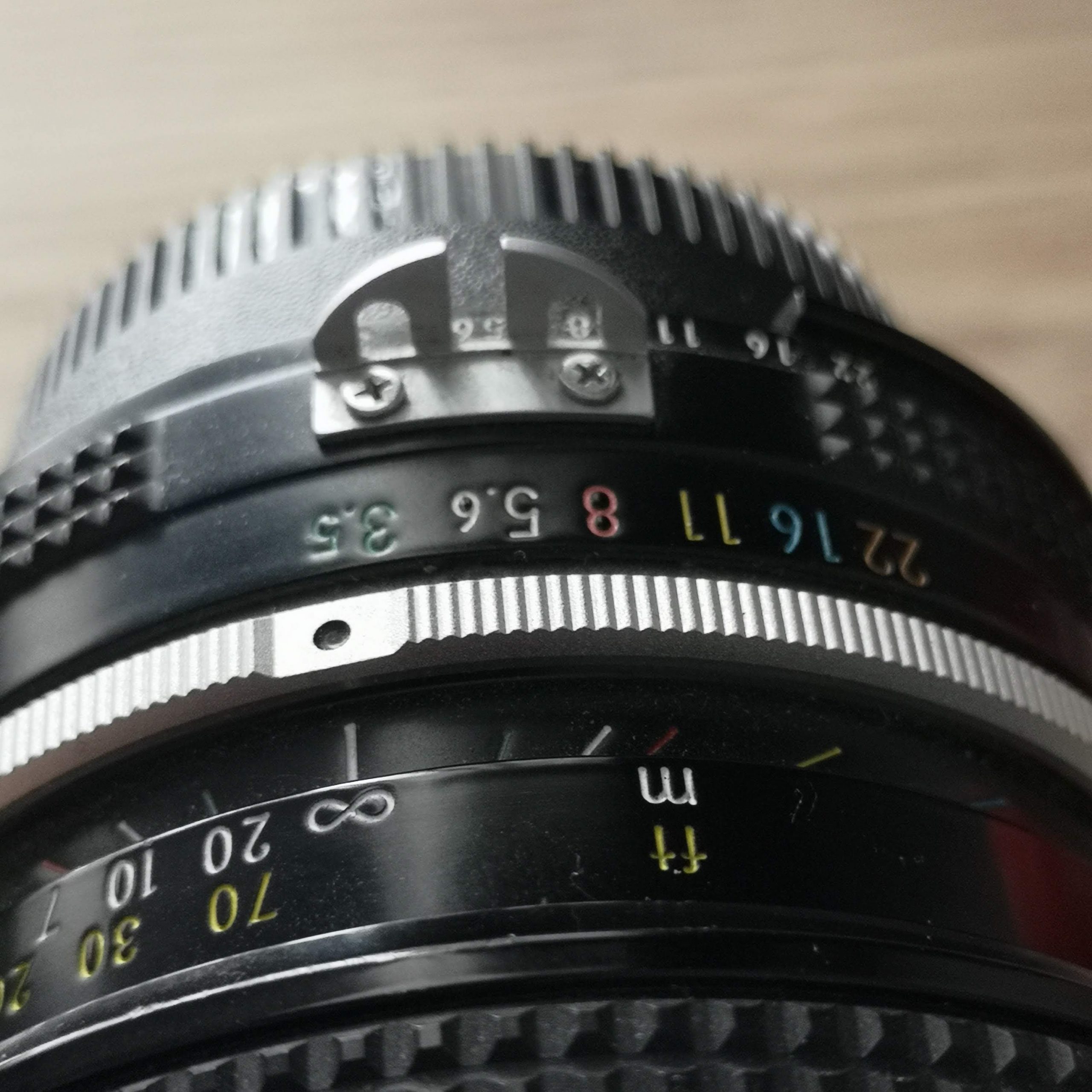
In 1977 they introduced the AI revision, which uses a small ridge on the lens base rather than the prongs making mounting much quick and easier. All of our cameras above will use AI revision lenses (just some won’t meter).
Bar the professional F series and the first generation of New AI bodies like the FM, FE , EL2 and the Nikkormat FT3, AI bodies can’t safely mount these. Weirdly as some decidedly budget digitals can like the D40 – go figure ?
AI would be tweaked with the AI-S revision in 1981 – this benefits predominately AF cameras but is cross compatible with older AI bodies and vice versa.
Most manual focus AI & AI-S lenses (bar the E series lenses for the EM) have rabbit ears to be backwardly compatible. Even newer AF-D lenses which lack these but have an aperture ring, can still often be used on pre-AI bodies with stop down metering.
AF arrives 1986
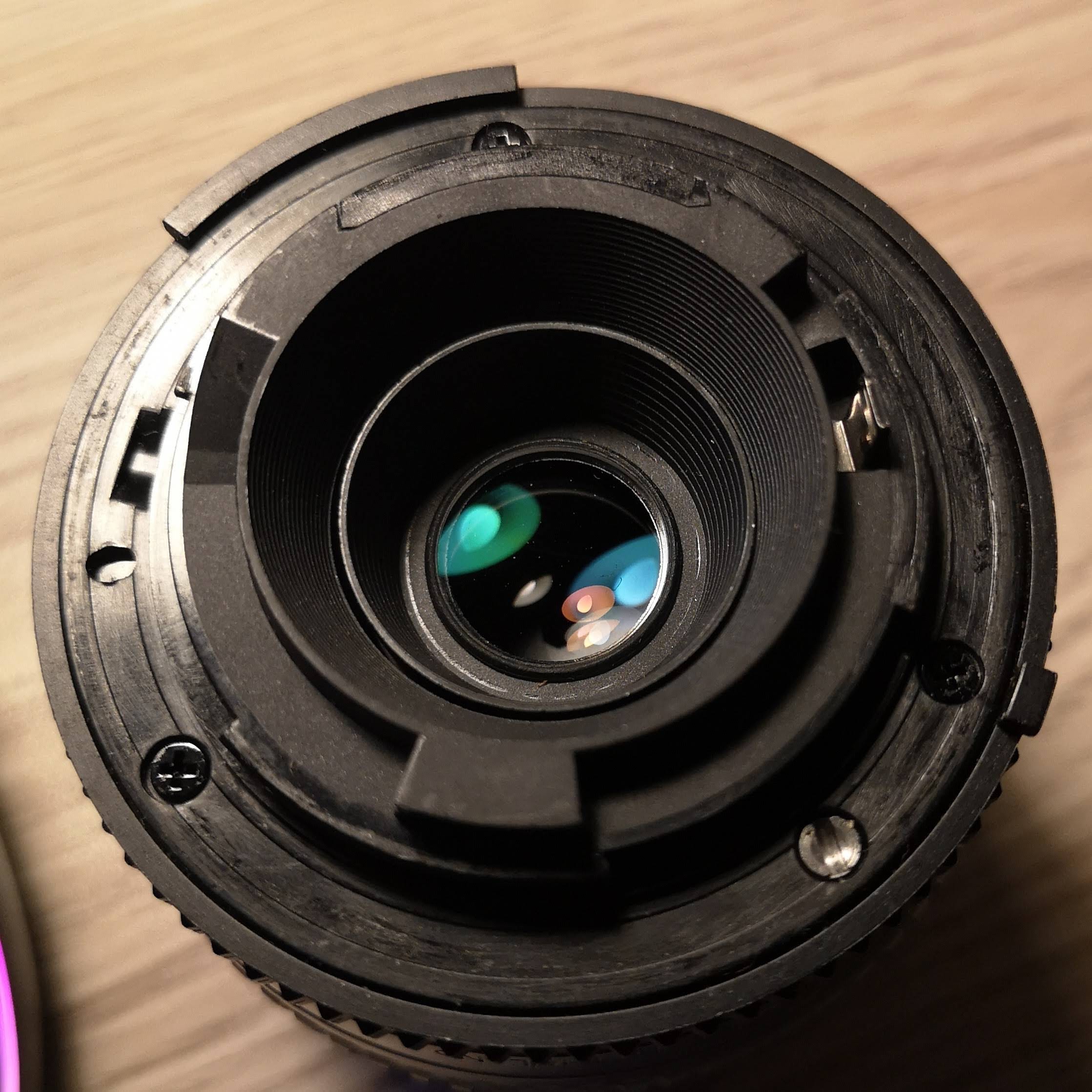
Successful Autofocus (sorry F3AF) arrives in 1986. AF is the designation of the original lenses . They use a motor on the camera body to power the lens. Later revisions led to AF-D lenses which allowed the camera to know the focal distance – handy for flash control. The system was very successful but be came dated rapidly. By the end of the 80’s it was slower than systems like the Canon EF mount. Most manual focus AI bodies can use a AF-D lens provided it has a manual aperture ring. Both have 5 electrical coupling pins on the lens mount (see below)

It’s important to note that last point as around this time, Nikon introduced G class lenses. These lack an aperture ring and have no AI ridge. Control of aperture is by the body and requires electrical connection. This makes them useless on cameras that require a mechanical connection (i.e. every manual focus SLR bar the FA). G class lenses can be AF-D but are also used can be newer AF-S lenses.
Nikon’s response was to follow it’s rivals. AF-I lenses moves the motor onto the lens from 1992. Just 4 years later they got a minor revision to become AF-S lenses. The difference really being a more silent motor. Most budget film models won’t support these for AF. Ironically almost all budget dSLR will work with AF-S but not AF-D. These have between 7-10 contact pins (handy if trying to work out a G class lens)
Nikon’s newest lenses so called AF-P will not work with any film body. Or infact any digital body made before 2013.
FX & DX lenses
Today Nikon still makes a few manual focus AI lenses. It’s main focus is it’s digital lenses and these are divided into 2 groups. The full frame FX lenses are just 35mm lenses and will work fine providing the tech otherwise matches. But Nikon also make DX lenses for cropped APS sized sensors. DX lenses often vignette when used on a full frame or 35mm film body and I have found support can be finicky (my F75 worked fine with the lens below but not my F90x)
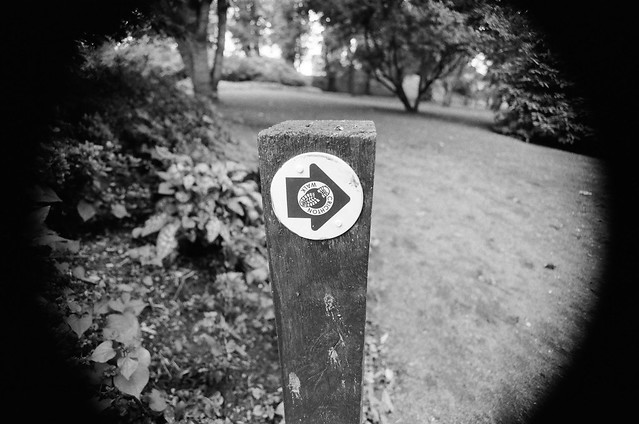
For more on compatibility and Nikon lens tech Ken Rockwell has some excellent guides. I haven’t included everything but Ken does
Notes
* Before you toast me and say well Pentax do to. Just remember that Pentax’s original SLR mount was the East German M42 screw. They only switched to the K mount in 1975. Numerous legendary Pentax cameras (notably the spotmatics are M42). Kudos you can still buy a Pentax dSLR using the K mount but in reality it’s a Ricoh. Both Canon & Minolta (aka now Sony) ditched their Legacy mounts in the 1980’s.

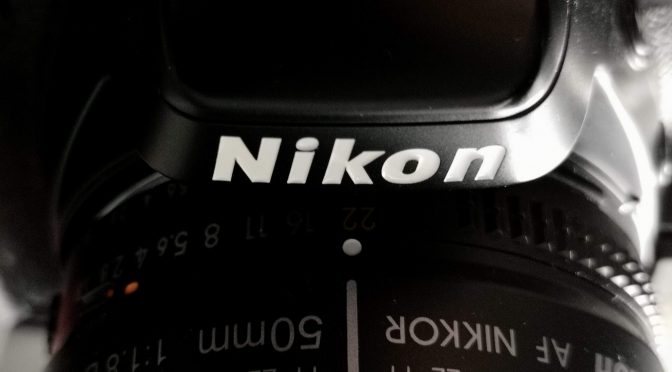
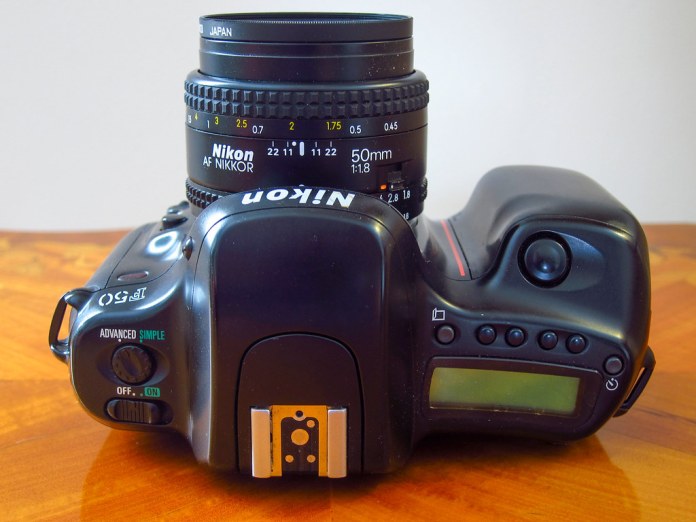
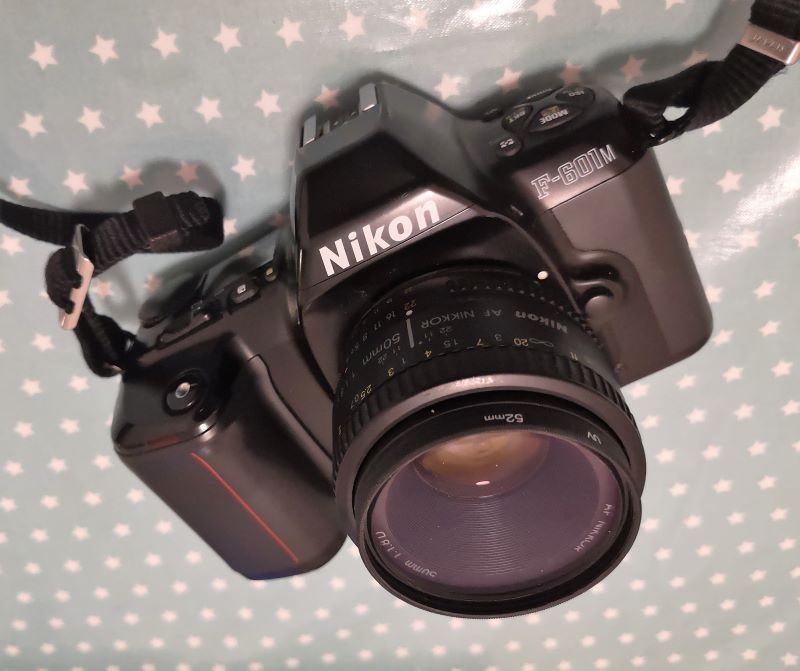

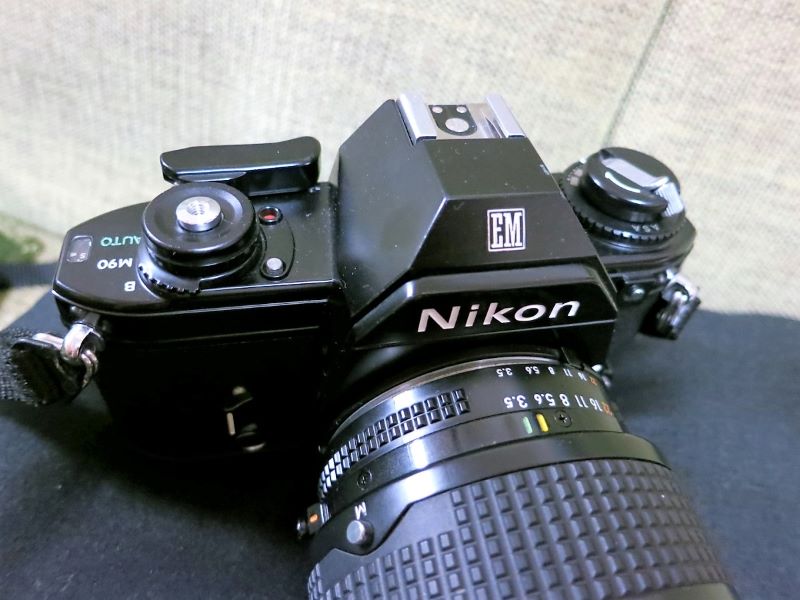
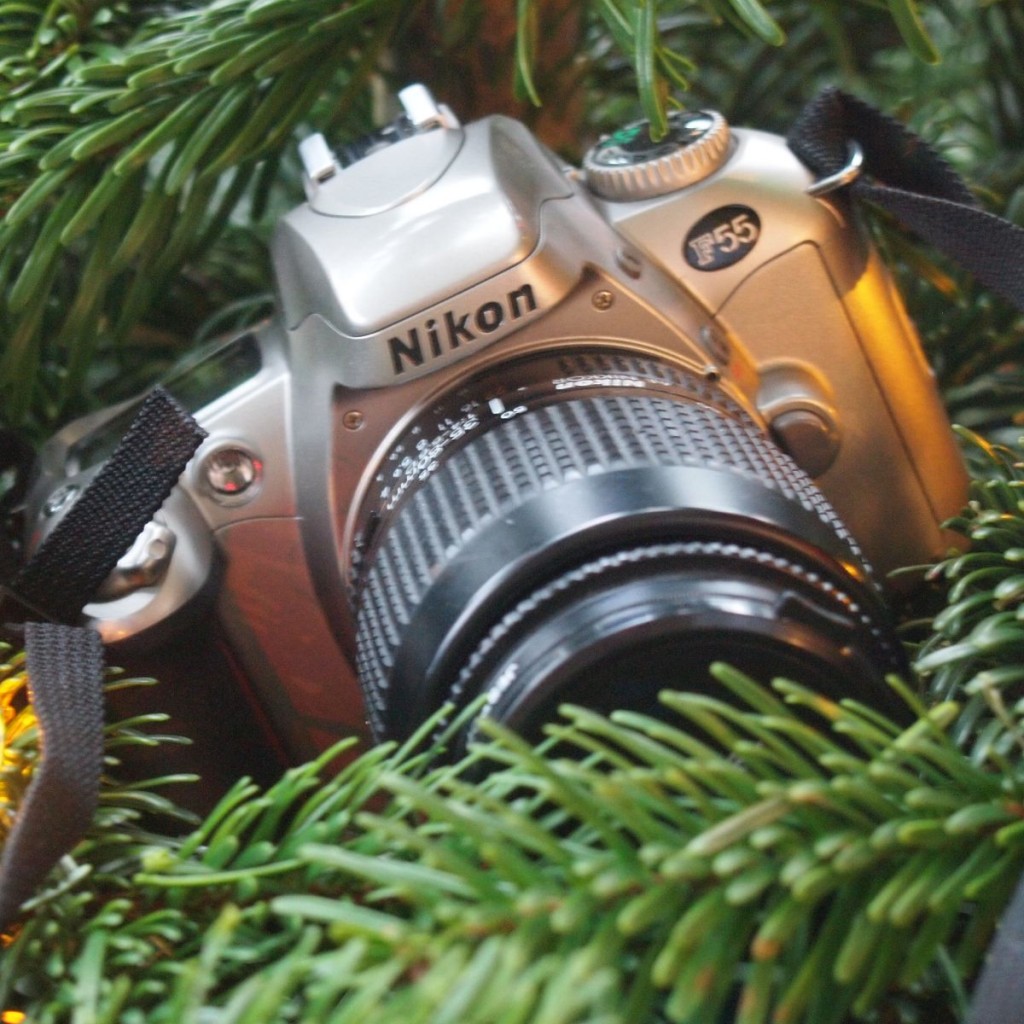

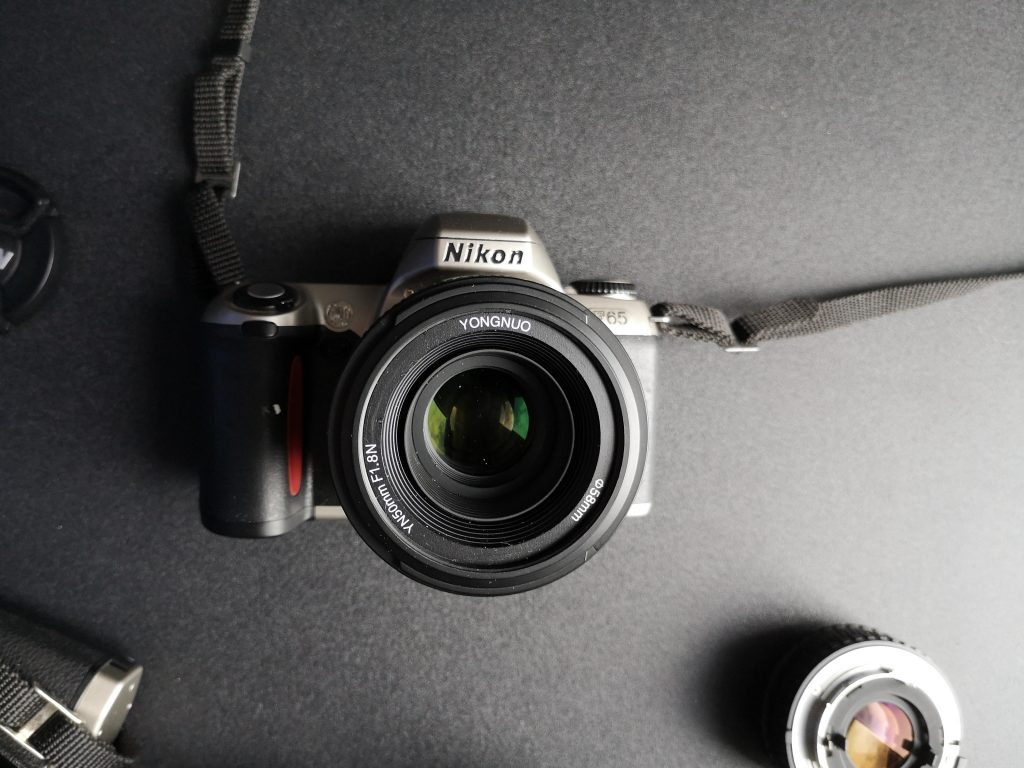
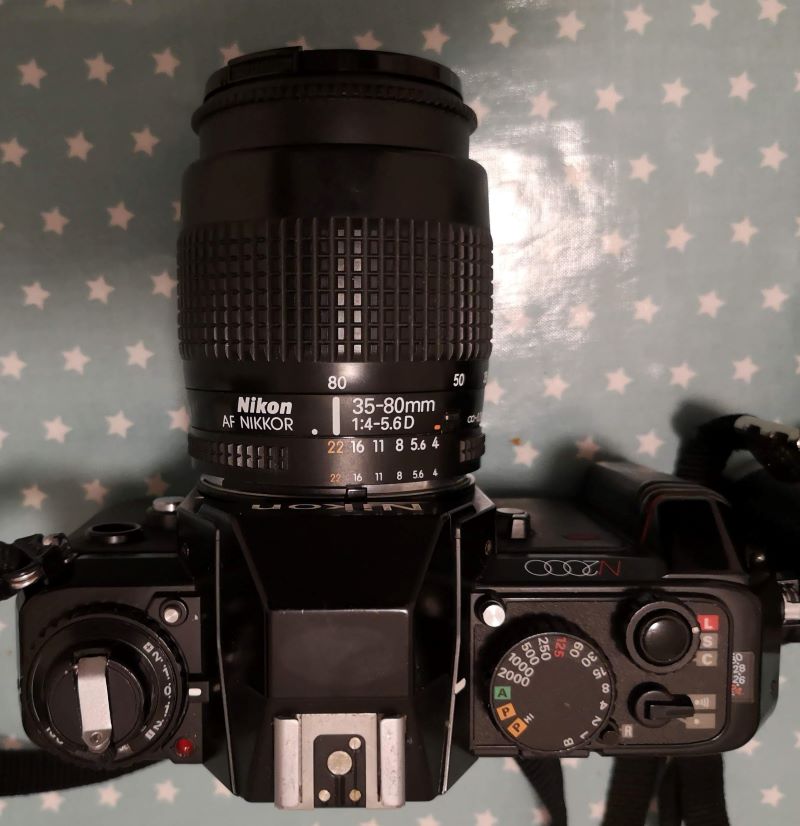
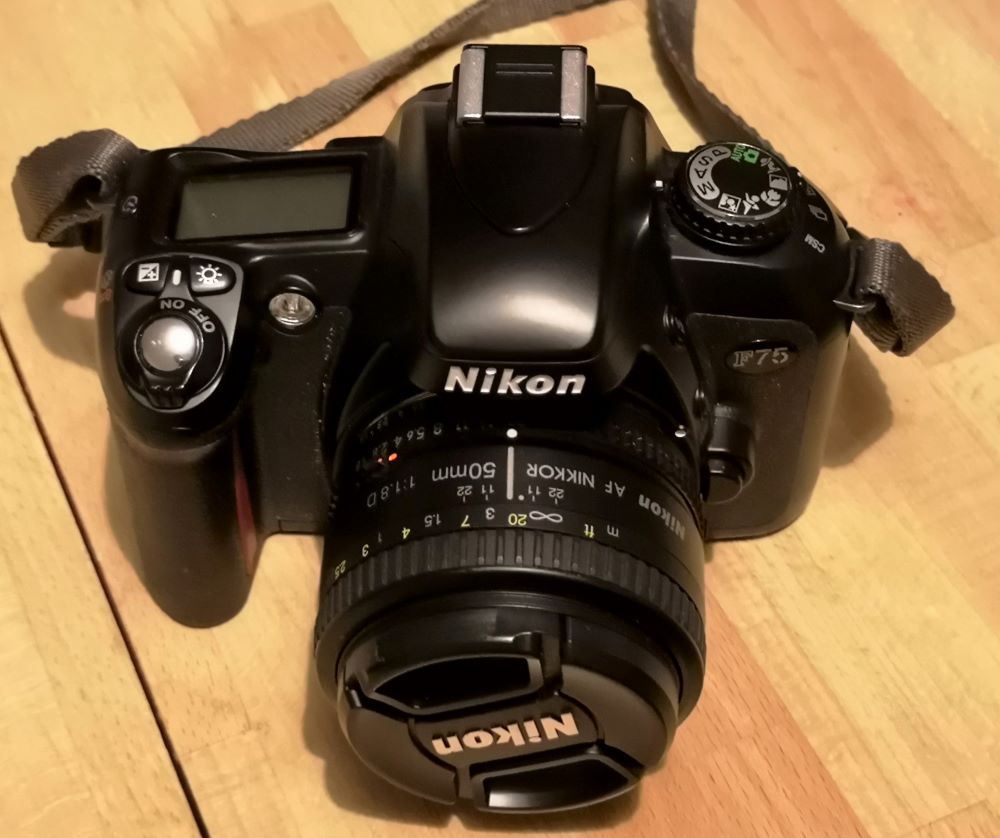
Quantaray, I believe, was the house name of the Sears department store in the US. They branded stuff from various manufacturers over the years; by the styling that’s a Sigma lens.
Think you might be right re the Sigma. However Jim was none too impressed though and I tend to find Sigma lenses pretty good
You are correct Nigel, the lens on the F60 is a Sigma produced model.
Quantaray was actually the house brand for the Ritz Camera corporation. Their AF lenses were largely sourced from Sigma and Tamron. If the internet is to be believed, Quantaray gear was of lesser quality than the mainline Sigma and Tamron gear but I don’t know how believable that is.
I have a Quantaray 70-300mm zoom that takes absolutely beautiful pictures when used within its limits.
I think that’s outstanding Nikon stated the Nikon M was for women! I love it!
Hello, thank you for such an informative article. We really are spoilt for choice
No mention of F70, not a fan of the ‘fan’?
Andrew
I own a F-601M so no issues there. The F70 was one of several almost in the list. When I checked a few weeks back when starting this just wasn’t quite coming in at under £20 a body. My F90x cost me under 40 quid with lens that would have brought me under this target. But they both are not typical – the cameras tend to sell over the £20 body and the body+ lens price on average. The Nikkormat FTn I’d written up but had to pull from this list as again it was going for over £20
These budget-friendly Nikon film bodies are like the hidden treasures of the photography world! Who knew you could snag a film camera for less than the cost of a fancy coffee? Time to raid those couch cushions for spare change and start your analog adventure!